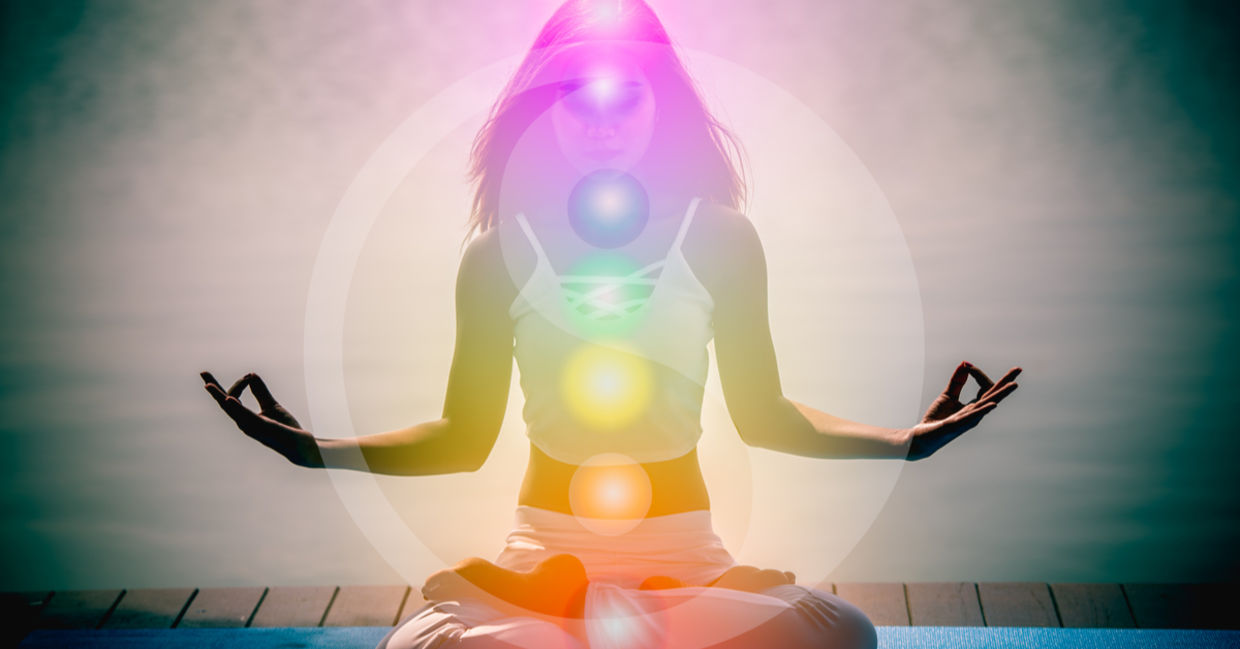
(May_Chanikran / Shutterstock.com)
According to Hindu and Buddhist traditions, the physical and spiritual come together in the chakras. In Sanskrit, the word chakra means “wheel”: These swirling wheels of energy align along the spine connecting our mind, body, and soul.
The Seven Chakras:
1. Root chakra (Muladhara chakra)
2. Sacral chakra (Svadhisthana chakra)
3. Solar plexus chakra (Manipura chakra)
4. Heart chakra (Anahata chakra)
5. Throat chakra (Vishuddha chakra)
6. Ajna chakra (Third-eye chakra)
7. Crown chakra (Sahasrara chakra)
As you can see, each chakra corresponds to an area in the body along the spine. Think of chakras as spinning wheels of life force and energy that run vertically from the base of the body to the crown of the head and beyond. Each chakra also has its corresponding color determined by its energy frequency.
Why Do Chakras Matter?
When the chakras balance, we feel balanced. When aligned, the chakras swirl effortlessly and bring a sense of wholeness in our mind, body, and soul. We feel at ease in our relationships, actions, and thoughts. Think of a balanced chakra system as a stream of water that flows smoothly.
When the chakras are unbalanced, we feel unbalanced. When one chakra becomes overactive while another underactive, our chakras misalign. Tension builds in the body and negative, self-defeating thought patterns develop.
Understanding the chakra system helps to understand how external circumstances and internal thought patterns affect the mind and body. Physical postures and meditation practices that correspond to each chakra can help release tension stored in the body, let go of negative habits, and restore the chakras into balance. We release old worries that stagnate our lives and live in harmony with ourselves.
The Chakras Explained:
1. Root chakra (Muladhara chakra)
“I am always safe at the center of my being.”
The first chakra begins at the base of the spine. The root chakra corresponds to the earth element and to the roots we’ve planted, how strong they are, how deep they are, and how supportive they are. It coincides with fundamental needs like food, water, shelter, home, and family.
When in balance, we feel grounded, secure, and safe.
When out of balance, we feel insecure and anxious. We experience weight gain, depression, and stress.
Location: Base of the spine
Color: Red
Element: Earth
2. Sacral chakra (Svadhisthana chakra)
“I flow with the rhythms of life.”
The sacral chakra corresponds to emotional and sexual energy in the body. Located in the lower abdomen, the sacral chakra coincides with the element of water, Like water, the sacral energy controls fluidity, versatility, and freedom, whether sexual, emotional, or creative.
When in balance, we feel creative and abundant with pleasure and fulfilling relationships.
When out of balance, we feel emotionally unstable, sexual dysfunction, and lack creative energy. In the body, the sacral chakra connects with reproductive issues and lower back pain.
Location: Above the pubic bone and below the navel (the sex organ area)
Color: Orange
Element: Water
3. Navel chakra (Manipura chakra)
“I stand in my personal power.”
Located in the upper abdomen, the navel chakra coincides with self-esteem and asserting yourself. The chakra governs personal power and identity and connects to digestion and metabolism.
When in balance, we feel confident with a sense of purpose and motivation.
When out of balance, we feel domineering or aggressive and have low self-esteem.
Location: The navel area, from the solar plexus up to the breastbone
Color: Yellow
Element: Fire
4. Heart chakra (Anahata chakra)
“I open my heart to fully living.”
The three upper and three lower chakras connect in the center of the body at the heart chakra. The heart chakra corresponds with love, compassion, kindness, and harmonious relationships with ourselves and others.
When in balance, we feel love, compassion, and forgiveness for ourselves and others.
When out of balance, we feel unworthy, co-dependent, and disdainful. We may also experience high blood pressure or poor circulation.
Location: Center of the chest (including the heart, lungs, and surrounding area)
Color: Green
Element: Air
5. Throat chakra (Vishuddha chakra)
“I follow and speak my truth.”
The throat chakra relates to how we communicate and express ourselves. Because it represents the first of the upper, spiritual chakras, the lower four chakras must align for the throat chakra to balance.
When in balance, we speak, listen, and express ourselves openly and authentically.
When out of balance, we have difficulty expressing our needs and listening to others. We can develop a sore throat or neck and shoulder pain.
Location: The throat
Color: Blue
Element: Space
6. Third-eye chakra (Ajna chakra)
“I follow the path of truth and intuition.”
The third-eye chakra sits at the top of the spine between the eyebrows and relates to how we connect the external world with our internal dialogue.
When balanced, we trust our intuition, release our ego, and develop strong inner wisdom.
When out of balance, we become cynical and too attached to external circumstances. We may also have problems with headaches and vision.
Location: The space between the eyebrows
Color: Indigo
Element: All
7. Crown chakra (Sahasrara chakra)
“There is only divine oneness.”
Sahasrara is the final chakra that corresponds to the spiritual being. This chakra allows you to transcend the physical world for a divine experience.
When in balance, we feel enlightened and a spiritual connection to our higher selves.
When out of balance, our happiness depends on external conditions. We become hyper-sensitive and struggle to function.
Location: Outside the body and hovering above the crown of the head
Color: Violet or White
Element: Cosmic Energy
At first, beginners to meditation may sense the chakras lightly or not at all. With practice, the subtle chakra energy becomes stronger, allowing you to build a deeper connection to where soul meets body.







